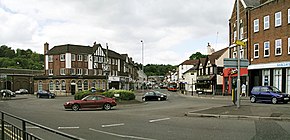Tandridge District
| Tandridge District | |
|---|---|
| Non-metropolitan district | |

Caterham, the largest town in Tandridge
|
|
| Motto: Concordia (Latin: Harmony) |
|
 Tandridge shown within Surrey |
|
| Sovereign state | United Kingdom |
| Constituent country | England |
| Region | South East England |
| Non-metropolitan county | Surrey |
| Status | Non-metropolitan district |
| Admin HQ | Oxted |
| Incorporated | 1 April 1974 |
| Government | |
| • Type | Non-metropolitan district council |
| • Body | Tandridge District Council |
| • Leadership | Alternative - Sec.31 (Conservative) |
| • MPs | Sam Gyimah |
| Area | |
| • Total | 95.8 sq mi (248.2 km2) |
| Area rank |
154th (of 326) Highest point : Botley Hill |
| Population (mid-2015 est.) | |
| • Total | 86,000 |
| • Rank | 278th (of 326) |
| • Density | 900/sq mi (350/km2) |
| • Ethnicity | 93.8% White 2.0% S.Asian 1.8% Black 1.4% Mixed Race |
| Time zone | GMT (UTC0) |
| • Summer (DST) | BST (UTC+1) |
| ONS code | 43UK (ONS) E07000215 (GSS) |
| OS grid reference | TQ3954252860 |
| Website | www |
154th (of 326)
Tandridge is a local government district in east Surrey, England containing part of the North Downs Area of Outstanding Natural Beauty, part of the Weald and the towns of Warlingham, Caterham, Oxted, Godstone and Lingfield. The area has several woodlands and some open heathland. Elevations above sea level range from 267 m (876 ft) at Botley Hill, North Downs to 42 m (138 ft) near Edenbridge. The district council offices are in Oxted, the second biggest settlement in the district.
The district borders the Borough of Crawley (in West Sussex) to the south west, the district of Mid Sussex (also in West Sussex) to the south, the district of Wealden (in East Sussex) to the south east, the Borough of Reigate and Banstead to the west, Sevenoaks District (in Kent) to the east and the London Boroughs of Croydon and Bromley to the north.
It is named after a hillside village and slope on the south slope of the North Downs, Tandridge. Tandridge hundred, an early local government district, covered roughly the same area. By the late 19th century, hundreds were no longer relevant, and urban and rural districts replaced any remaining functions in 1894.
...
Wikipedia
